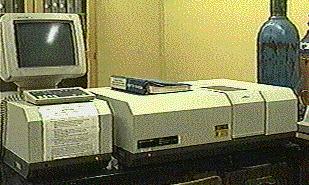Infrared Absorption Spectrometers
Introduction
This document describes dispersive and Fourier-transform spectrometers
that are used in infrared absorption spectroscopy.
Common light
sources are tungsten lamps, Nernst glowers, or glowbars. IR
detectors consist of a semiconductor such as PbS or liquid-nitrogen-cooled
HgCdTe (also called MCT).
Dispersive infrared spectrometer
Dispersive IR spectrometers use a diffraction grating in a monochromator
to disperse the different wavelengths of light. Dispersive IR spectrometers
have largely been replaced with FTIR instruments. They find some use in
specific applications, such as monitoring a single IR wavelength to measure
the kinetics of a fast reaction.
Schematic of a dispersive IR absorption spectrometer

Fourier-transform infrared (FTIR) spectrometer
Most modern IR absorption instruments use Fourier-transform
techniques with a Michelson
interferometer. To obtain an IR absorption spectrum, one mirror of
the interferometer moves to generate interference in the radiation reaching
the detector. Since all wavelengths are passing through the interferometer,
the interferogram is a complex pattern. The absorption spectrum as a function
of wavenumber (cm-1) is obtained from the Fourier transform
of the interferogram, which is a function of mirror movement (cm). This
design does not have the reference cell of a dispersive instrument, so
a reference spectrum is recorded and stored in memory to subtract from
the sample spectrum.
Picture of an FTIR absorption spectrometer

Auf diesem Webangebot gilt die Datenschutzerklärung der TU Braunschweig mit Ausnahme der Abschnitte VI, VII und VIII.


